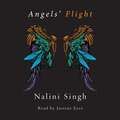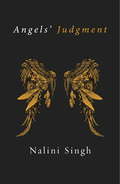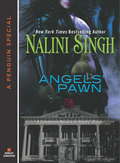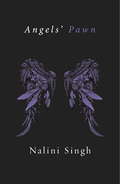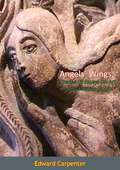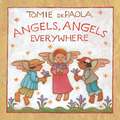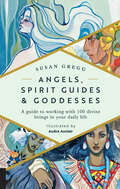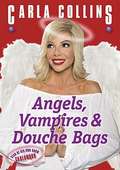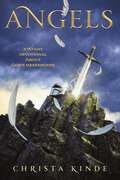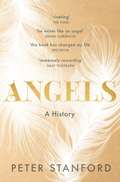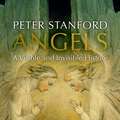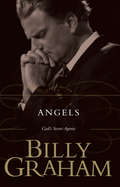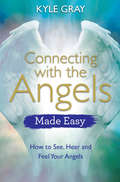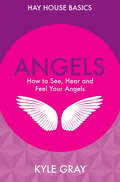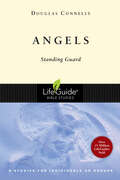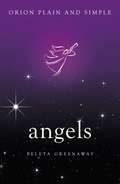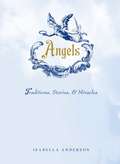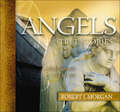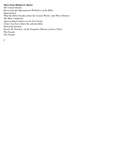- Table View
- List View
Angels' Flight: A Guild Hunter Collection (The Guild Hunter Series)
by Nalini SinghWarrior angels, vampire hunters and angels gone bad heat up this altogether sizzling paranormal alternate universe.This anthology of novellas features Angels' Wolf, Angels' Judgement, Angels' Pawn and the never-before-published Angels' Dance. Read by Justine Eyre
Angels' Judgment: A Guild Hunter Novella (The Guild Hunter Series)
by Nalini SinghWarrior angels, vampire hunters, and angels gone bad heat up this altogether sizzling paranormal alternate universe, from the bestselling author Nalini Singh.Angels' Judgementis the compelling story of passion, love and danger in the Guild Hunter world. Sara and Deacon are Guild Hunters, their life's work is catching and capturing - or killing - rogue angels. It's dangerous work and sometimes life or death decisions must be made in a moment. And when a judgement has to be made, should love be allowed to get in the way . . . ?This is a compelling, sexy addition to the Guild Hunter universe.
Angels' Pawn
by Nalini SinghThis is a companion novella for the Guild Hunters series that starts with Angel's Blood.
Angels' Pawn: A Companion Novella to Angels# Blood
by Nalini SinghAngels’ Pawn introduces readers to a world of beauty and danger where angels and vampires coexist. The novella is the prequel to Nalini Singh’s Guild Hunter series. In Atlanta, a vampire hunter is caught between two rival factions and the angel who is manipulating them both. Her only assistance comes from a vampire who may have his own reasons for helping her...
Angels' Pawn: A Guild Hunter Novella (The Guild Hunter Series)
by Nalini SinghWarrior angels, vampire hunters and angels gone bad heat up this altogether sizzling paranormal alternate universe, from the bestselling author Nalini Singh.Angels' Pawn is a tale of flirtation and danger set in the Guild Hunter world. Ashwini and Janvier have no reason to be drawn to each other - but they are. Even when they're on opposite sides of a debate there's a spark between them which doesn't want to die. Will it be fanned to become a flame ... or are they both the pawns of angels?This is a compelling, sexy addition to the Guild Hunter universe.
Angels' Wings: A Series Of Essays On Art And Its Relation To Life
by Edward Carpenter“THERE is a strong impression that the Democratic idea as it grows and spreads will have a profound influence on Art and artistic methods; and that Art, in its relation to life generally, is in these days passing into new phases of development. The following papers have been largely occasioned by some such feeling.”Edward Carpenter was an English socialist poet, socialist philosopher, anthologist, and early gay activist.A leading figure in late 19th- and early 20th-century Britain, he was instrumental in the foundation of the Fabian Society and the Labour Party. A poet and writer, he was a close friend of Walt Whitman and Rabindranath Tagore, corresponding with many famous figures such as Annie Besant, Isadora Duncan, Havelock Ellis, Roger Fry, Mahatma Gandhi, James Keir Hardie, J. K. Kinney, Jack London, George Merrill, E D Morel, William Morris, E R Pease, John Ruskin, and Olive Schreiner.
Angels, Angels Everywhere
by Larry LibbyBest-loved Somewhere Angels now revised and updated” Why Can’t We See Angels? What Do Angels Look Like? Where are Angels When We Need Them? Children have a natural ability to accept the reality of angels. And angels are very important in their lives. They are all around, and they are here to protect us. Using gentle and biblically-based text, author Larry Libby provides comforting answers to questions children (and adults) might ask about angels. The warm, soft illustrations reassure young children that God’s special messengers are always near, and God created them to watch over all of us. Through imaginative and innovative products, Zonderkidz is feeding young souls.
Angels, Angels Everywhere
by Tomie dePaolaDid you know there are angels all around? Angels who look after ordinary activities like waking up and going to school? Angels who watch over you at tea parties and dress-up time?In Angels, Angels Everywhere, Tomie dePaola presents an appealing collection of "everyday" angels, rendered in luminous fresco-style illustrations. Using just the names of the angels as text, he artfully shows how these angels help kids throughout the course of a typical day.From the Get-Dressed Angel in the morning to the Goodnight Angel at night, Angels, Angels Everywhere is a wonderful celebration of warmth and giving sure to lend comfort to any reader. After all, everyone can use an angel!
Angels, Demons and the New World
by Fernando Cervantes Andrew ReddenWhen European notions about angels and demons were exported to the New World, they underwent remarkable adaptations. Angels and demons came to form an integral part of the Spanish American cosmology, leading to the emergence of colonial urban and rural landscapes set within a strikingly theological framework. Belief in celestial and demonic spirits soon regulated and affected the daily lives of Spanish, Indigenous and Mestizo peoples, while missionary networks circulated these practices to create a widespread and generally accepted system of belief that flourished in seventeenth-century Baroque culture and spirituality. This study of angels and demons opens a particularly illuminating window onto intellectual and cultural developments in the centuries that followed the European encounter with America. The volume will be of interest to scholars and students of religious studies, anthropology of religion, history of ideas, Latin American colonial history and church history.
Angels, Spirit Guides & Goddesses: A Guide to Working with 100 Divine Beings in Your Daily Life
by Susan GreggMeet one hundred celestial helpers who are ready to provide guidance: “Informational as well as inspirational . . . No matter your spiritual tradition.” —New Spirit JournalCelestial helpers surround us in abundance, simply awaiting our call. Angels, Spirit Guides and Goddesses is a lively reference to who’s who in the celestial realms. Featuring 100 divinities from spiritual traditions both current and ancient, this guide shows you how to call upon divine help in all areas of your life, from relationships, to career and money, to home and family. Angels, Spirit Guides and Goddesses offers an overview of each deity, their purpose, and how you can call upon them for assistance. Need protection? Call upon Archangel Michael. To find your true soul mate, open your heart to the Hindu god, Krishna. Want assistance with healing or communicating with animals? Invoke Saint Francis. Is your life in need of excitement? Call upon Hawaiian volcano goddess Pele to stoke your passion and inner fire! Beautifully illustrated in full color, Angels, Spirit Guides and Goddesses helps you to easily connect with the essence of each guide and call upon them for magical help and support.
Angels, Vampires and Douche Bags
by Carla CollinsA HILARIOUS AND UPLIFTING MOTIVATIONAL BOOK LIKE NO OTHERIn this candid confessional, comedian Carla Collins divides the world into the angels who guide us, inspire us, and save our butts; the sexy and trendy vampires who suck the life out of us; and the douche bags who constantly annoy, disgust and taunt us.With a fast wit, fake breasts and real heart, Collins shares her unconventional journey from a small steel town in Ontario, Canada to Tinseltown L.A. On this wild and revealing romp, she navigates her way through seventy-two imaginary friends, multiple fiancés, eight dogs, two marriages, and one topless grandmother. Her hard-earned life lessons will show you that by taking risks, embracing humiliation and tapping into the power of laughter, anything is possible-and everyone is manageable.Attract more angels into your life, control your vampires, and keep all the douche bags at bay. Angels, Vampires and Douche Bags is original, edgy, uplifting and laugh-out-loud funny.
Angels: A 90-Day Devotional
by Christa J. KindeGuardian angels. Divine messengers. Fiery spirits. Winged cherubim. The realm where these beings live is invisible to us. Most of the time, so are the angels themselves. So how do we know they’re real? How can we be sure they’re there? And what do we really know about them? Angels: a 90-Day Devotional about God’s Messengers explores over one hundred Bible passages in which angels make an appearance. In addition, there are Q and As, myths busters, hymns, Bible story retellings, pop culture references, and trivia that help you sort fact from fiction. So spend the next ninety days really exploring the world of angels, and learn more about what is taking place all around you.
Angels: A History
by Peter Stanford'An intriguing exploration of the many roles that angels have played in spiritual life.' - The Sunday Times: Nick Rennison 'In a 2016 poll, one in 10 Britons claimed to have experienced the presence of an angel, while one in three remain convinced that they have a guardian angel. These are huge numbers and mean that, on some counts, angels are doing better than God.'In the secular, sceptical, post-Christian world of the West, continuing faith in angels is both anomaly and comfort. But what exactly are angels, and why have so many in different times and contexts around the globe believed in them? What is their history and role in the great faiths and beyond their walls? Are angels something real, a manifestation of divine concern? Or part of the poetry of religion? And can they continue to illuminate a deeper truth about human existence and the cosmos? These are not new questions. They have been asked over millennia, right up to the present day, as writer, journalist and broadcaster Peter Stanford explores in Angels, his latest investigation into the history, theology and cultural significance of religious ideas.'There is no better navigator through the space in which art, culture and spirituality meet than Peter Stanford' Cole Moreton, Independent on Sunday
Angels: A History
by Peter Stanford'In a 2016 poll, one in 10 Britons claimed to have experienced the presence of an angel, while one in three remain convinced that they have a guardian angel. These are huge numbers and mean that, on some counts, angels are doing better than God.'In the secular, sceptical, post-Christian world of the West, continuing faith in angels is both anomaly and comfort. But what exactly are angels, and why have so many in different times and contexts around the globe believed in them? What is their history and role in the great faiths and beyond their walls? Are angels something real, a manifestation of divine concern? Or part of the poetry of religion? And can they continue to illuminate a deeper truth about human existence and the cosmos? These are not new questions. They have been asked over millennia, right up to the present day, as writer, journalist and broadcaster Peter Stanford explores in Angels, his latest investigation into the history, theology and cultural significance of religious ideas. 'There is no better navigator through the space in which art, culture and spirituality meet than Peter Stanford' Cole Moreton, Independent on Sunday(P) 2019 Hodder & Stoughton Ltd
Angels: A Novel
by Denis Johnson“A terrifying book, a mixture of poetry and obscenity. . . [the characters] are people who can’t be ignored. Mr. Johnson has written a dazzling and savage first novel.”—Alice Hoffman, New York Times Book Review The most critically acclaimed, and first, of Denis Johnson's novels, Angels puts Jamie Mays—a runaway wife toting along two kids—and Bill Houston—ex-Navy man, ex-husband, ex-con—on a Greyhound Bus for a dark, wild ride cross country. Driven by restless souls, bad booze, and desperate needs, Jamie and Bill bounce from bus stations to cheap hotels as they ply the strange, fascinating, and dangerous fringe of American life. Their tickets may say Phoenix, but their inescapable destination is a last stop marked by stunning violence and mind-shattering surprise. Denis Johnson, known for his portraits of America's dispossessed, sets off literary pyrotechnics on this highway odyssey, lighting the trek with wit and a personal metaphysics that defiantly takes on the world.
Angels: God's Secret Agents
by Billy Graham"Angels are the dispensers and administrators of the divine beneficence toward us. They regard our safety, undertake our defense, direct our ways, and exercise a constant solicitude that no evil befall us." Angels have a much more important place in the Bible than the devil and his demons. Therefore, I undertook a biblical study of the subject of angels. Not only has it been one of the most fascinating studies of my life, but I believe the subject is more relevant today than perhaps at any time in history. The Bible teaches that angels intervene in the affairs of nations.
Angels: God's Secret Agents
by Billy GrahamDr. Graham lifts the veil between the visible and the invisible world to give us an eye-opening account of these behind-the-scenes agents. This best-selling classic records the experiences of Dr. Graham and others who are convinced that at moments of special need they have been attended by angels. Yes, angels are real. They are not the product of your imagination. Dr. Graham lifts the veil between the visible and the invisible world to give us an eye-opening account of these behind-the-scenes agents. This best-selling classic (with more than 750k copies in print) records the experiences of Dr. Graham and others who are convinced that at moments of special need they have been attended by angels. With keen insight and conviction, Dr. Graham affirms that:God's invisible hosts are better organized than any of the armies of man—or Satan.Angels "think, feel, will, and display emotions."Angels guide, comfort, and provide for people in the midst of suffering and persecution.At death, the faithful will be ushered by angels into the presence of God. &“If we had open spiritual eyes we would see not only a world filled with evil spirits and powers—but also powerful angels with drawn swords, set for our defense.&” —Billy Graham
Angels: How To See, Hear And Feel Your Angels
by Kyle GrayHay House Basics is a comprehensive new series being launched by Hay House. These introductory titles cover core topics in the areas of self-development and mind, body, spirit. Clear and concise, these books aim to de-mystify popular esoteric subjects so that anyone can understand them. They explore the benefits these techniques can have for the reader’s life, and provide recommendations and suggested next steps for them if they wish to study the topic on a deeper level. The first book in this series is Angels: How to See, Hear and Feel Your Angels. Taking you on an exciting journey into the hidden realms of these angelic beings, this book will help you to allow their energy into your life and accept the support that the angels really want to give you. Discover: the purpose of the angels how to see, hear and feel the presence of the angels the angelic ‘hierarchy’ and how to work with different angels for help in different areas of your life how to meet your guardian angel the power of the Archangels and how to connect to them how to work with prayers & affirmations … and much more!
Angels: How to See, Hear and Feel Your Angels
by Kyle GrayLearn how to communicate with the angels and interpret their signs for healing, support and guidance.Kyle Gray is one of the world's youngest, most sought-after angel experts. He discovered his spiritual gifts at the tender age of four and now dedicates his life to helping others tune in to their own intuitive talents. In this book, Kyle teaches readers how to connect with the angels and bring their divine, loving presence into all areas of life for powerful transformations.You will learn:- How to see, hear and feel the presence of the angels- Ways to communicate with the angels and ask for their help- How to receive messages from the angels and trust their guidance- The different types of angels and their role in each area of your life- How to meet your guardian angel
Angels: Standing Guard (LifeGuide Bible Studies)
by Douglas ConnellyDo angels really have wings? Do they protect people from harm? Can people become angels after death? Misconceptions about angels abound--in books, in movies and on talk shows. In this eight-session LifeGuide Bible Study, Douglas Connelly explores with you what the Bible really says about angels, including their service to God and their ministry to people. For over three decades LifeGuide Bible Studies have provided solid biblical content and raised thought-provoking questions—making for a one-of-a-kind Bible study experience for individuals and groups. This series has more than 130 titles on Old and New Testament books, character studies, and topical studies. PDF download with a single-user license; available from InterVarsity Press and other resellers.
Angels: The Only Book You'll Ever Need (Plain And Simple Ser.)
by Beleta GreenawayThroughout time, people of many cultures and religions have believed in angels. Now Beleta Greenaway brings you closer to these wonderful beings in this delightful guide. She shares some of her own experiences with angels and describes how you can make your own connections with them, whether through meditation, in dreams, using decks of special cards, or by other means.
Angels: Traditions, Stories, and Miracles
by Isabella AndersonA Heavenly Treasury of Angelic Lore!Every culture cherishes a winged spirit--from the ancient Egyptian ka and Norse Valkyries to Hindu apsaras and the archangels of the Bible. Featuring biblical tales, poetry, and lovely illustrations, this collection reveals the divine powers of angels, the history behind their existence, and the many ways you can include them in your life.For centuries, angels have served as messengers, warriors, and guardians who have a special bond with humans. Angels can help you release worry and guilt, heal physically and emotionally, and manifest your dreams. All you need to do is open yourself up to receive divine messages and insight. You'll discover the magic of signs, synchronicities, and coincidences and learn how to interpret their meaning as messages from angels.From the frightening cherubim guarding the entrance to the Garden of Eden with their flaming swords to the ethereal angels of the Renaissance, this collection is sure to captivate anyone interested in exploring the varied history, culture, and ideas of mysterious celestial beings.
Angels: True Stories
by Robert J. MorganYes, angels are real. They are not the product of your imagination. &“If we had open spiritual eyes we would see not only a world filled with evil spirits and powers—but also powerful angels with drawn swords, set for our defense.&”—Billy GrahamDr. Graham lifts the veil between the visible and the invisible world to give us an eye-opening account of these behind-the-scenes agents. This best-selling classic records the experiences of Dr. Graham and others who are convinced that at moments of special need they have been attended by angels. With keen insight and conviction, Dr. Graham affirms that:God's invisible hosts are better organized than any of the armies of man—or Satan.Angels "think, feel, will, and display emotions."Angels guide, comfort, and provide for people in the midst of suffering and persecution.At death, the faithful will be ushered by angels into the presence of God.
Angels: What The Bible Really Says About God's Heavenly Host
by Michael S. HeiserEveryone knows that angels have wings, usually carry harps, and that each of us has our own personal guardian angel, right? We all have some preconceptions about angels from movies, television shows, and other media, but you might be surprised to know that a lot of those notions aren't based on anything from the Bible. If you read Luke 1:26-38 and imagine the angel Gabriel standing before Mary with neatly folded white wings, you're not getting that picture from anything the Bible itself says.
Angels: What the Bible Really Says About God's Heavenly Host
by Michael S. HeiserWhat does the Bible really tell us about the heavenly host? Everyone knows that angels have wings, usually carry harps, and that each of us has our own personal guardian angel, right? We all have some preconceptions about angels from movies, television shows, and other media, but you might be surprised to know that a lot of those notions aren't based on anything from the Bible. If you read Luke 1:26–38 and imagine the angel Gabriel standing before Mary with neatly folded white wings, you're not getting that picture from anything the Bible itself says. What the Bible really says about angels is overlooked or filtered through popular myths. This book was written to help change that. It's a book about the loyal members of God's heavenly host, and while most people associate them with the word "angel," that's just one of many terms the Bible uses for supernatural beings. In The Unseen Realm Michael Heiser opened the eyes of thousands to seeing the Bible through the supernatural worldview of the ancient world it was written in. In his latest book, Angels, Dr. Heiser reveals what the Bible really says about God's supernatural servants. Heiser focuses on loyal, holy heavenly beings because the Bible has a lot more to say about them than most people suspect. Most people presume all there is to know about angels is what has been passed on in Christian tradition, but in reality, that tradition is quite incomplete and often inaccurate. Angels is not guided by traditions, stories, speculations, or myths about angels. Heiser's study is grounded in the terms the Bible itself uses to describe members of God's heavenly host; he examines the terms in their biblical context while drawing on insights from the wider context of the ancient Near Eastern world. The Bible's view on heavenly beings begins with Old Testament terms but then moves into literature from the Second Temple period—Jewish writings from around the fifth century BC to the first century AD. This literature from the time between the Old Testament and the New Testament influenced the New Testament writers in significant ways. With that important background established, the book focuses on what the New Testament tells us about God's holy ones. Finally, the book reflects on common misconceptions about angels and addresses why the topic is still important and relevant for Christians today.
